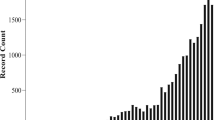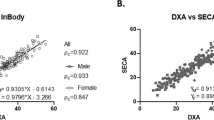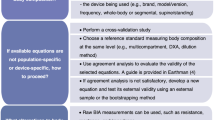Abstract
Objective
Excessive lean tissue loss following bariatric surgery may pose serious metabolic consequences. Accurate methods to assess body composition following bariatric surgery are required. This review aimed to investigate if multi-frequency bioelectric impedance (MF-BI) is a valid tool to determine body composition in obese patients.
Methods
MEDLINE, EMBASE, CINAHL and CENTRAL databases were searched until March 2017. Included studies were published in English with obese (body mass index (BMI) ≥ 30 kg/m2) adults measuring body composition with MF-BI methods in comparison with reference methods. Exclusions were pregnancy, animal studies, non-English language studies, single frequency BI. A total of 6395 studies were retrieved.
Results
Sixteen studies were eligible for inclusion. Sample sizes ranged from 15 to 157, with BMI 26–48 kg/m2. MF-BI underestimated fat mass (FM) in 11 studies and overestimated fat-free mass (FFM) in nine studies in comparison with reference methods. Correlations of absolute values from MF-BI and reference methods for FM and FFM were high, however, agreement was lower at an individual level. When adjustments for BMI were made to machine algorithms, measurement accuracy improved. Significant heterogeneity was evident among included studies.
Conclusions
This review found that MF-BI is reliable for use at a group level. Obese-specific adjustment of algorithms for MF-BI machines increases the accuracy of absolute measures of body composition in obese individuals, improving their utility in the clinical setting. Multiple variables contributed a lack of consistency among studies included, highlighting the need for more robust studies that control confounding variables to establish clear validity assessment.
This is a preview of subscription content, access via your institution
Access options
Subscribe to this journal
Receive 12 print issues and online access
$259.00 per year
only $21.58 per issue
Buy this article
- Purchase on Springer Link
- Instant access to full article PDF
Prices may be subject to local taxes which are calculated during checkout




Similar content being viewed by others
References
Colquitt J, Picot J, Loveman E, Clegg A, Kruseman M, Leimgruber A, et al. Surgery for obesity (Review). Cochrane Database Syst Rev. CD003641; 2009.
Vos T, Carter R, Barendregt J, Mehalopoulos C, Veerman L, Magnus A, et al. Assessing cost-effectiveness in prevention: ACE-prevention September 2010 final report. Brisbane, Qld: University of Queensland; 2010.
O’Brien PE, MacDonald L, Anderson M, Brennan L, Brown WA. Long-term outcomes after bariatric surgery: fifteen-year follow-up of adjustable gastric banding and a systematic review of the bariatric surgical literature. Ann Surg. 2013;257:87–94.
Buchwald H, Avidor Y, Braunwald E, et al. Bariatric surgery: a systematic review and meta-analysis. JAMA. 2004;292:1724–37.
Vaurs C, Dimeglio C, Charras L, Anduze Y, Chalret du Rieu M, Ritz P. Determinants of changes in muscle mass after bariatric surgery. Diabetes Metab. 2015;41:416–21.
Maggard MA, Shugarman LR, Suttorp M, Maglione M, Sugerman HJ, Livingston EH. Meta-analysis: surgical treatment of obesity. Ann Intern Med. 2005;142:547–59.
Carey DG, Pliego GJ, Raymond RL. Body composition and metabolic changes following bariatric surgery: effects on fat mass, lean mass and basal metabolic rate: six months to one-year follow-up. Obes Surg. 2006;16:1602–8.
Schollenberger AE, Karschin J, Meile T, Kuper MA, Konigsrainer A, Bischoff SC. Impact of protein supplementation after bariatric surgery: A randomized controlled double-blind pilot study. Nutrition. 2016;32:186–92.
McArdle W. Exercise physiology, energy, nutrition, and human performance. Philadelphia: Lippincott Williams; & Wilkins; 2001.
Pedersen BK, Febbraio MA. Muscles, exercise and obesity: skeletal muscle as a secretory organ. Nat Rev Endocrinol. 2012;8:457.
Teigen LM, Kuchnia AJ, Mourtzakis M, Earthman CP. The use of technology for estimating body composition:strengths and weaknesses of common modalities in a clinical setting. Nutr Clin Pract. 2017;32:20–9.
Earthman CP. Body composition tools for assessment of adult malnutrition at the bedside: a tutorial on research considerations and clinical applications. J Parenter Enter Nutr. 2015;39:787–822.
Kyle UG, Bosaeus I, De Lorenzo AD, Deurenberg P, Elia M, Gómez JM, et al. Bioelectrical impedance analysis-part I: review of principles and methods. Clin Nutr. 2004;23:1226–43.
Huang AC, Chen YY, Chuang CL, Chiang LM, Lu HS, Lin HC, et al. Cross-mode bioelectrical impedance analysis in a standing position for estimating fat-free mass validated against dual-energy x-ray absorptiometry. Nutr Res J. 2015;35:982–9.
Earthman C, Traughber D, Dobratz J, Howell W. Bioimpedance spectroscopy for clinical assessment of fluid distribution and body cell mass. Nutr Clin Pract. 2007;22:389–405.
Sun G, French CR, Martin GR, Younghusband B, Green RC, Xie Y-g, et al. Comparison of multifrequency bioelectrical impedance analysis with dual-energy X-ray absorptiometry for assessment of percentage body fat in a large, healthy population. Am J Clin Nutr. 2005;81:74–8.
Moher D, Liberati A, Tetzlaff J, Altman DG. Preferred reporting items for systematic reviews and meta-analyses: the PRISMA Statement. Ann Intern Med 2009;151:264–9.
Whiting PF, Rutjes AS, Westwood ME, et al. Quadas-2: a revised tool for the quality assessment of diagnostic accuracy studies. Ann Intern Med. 2011;155:529–36.
WHO. World Health Organization BMI Classification 2018 (Available from: http://apps.who.int/bmi/index.jsp?introPage=intro_3.html).
Pateyjohns IR, Brinkworth GD, Buckley JD, Noakes M, Clifton PM. Comparison of three bioelectrical impedance methods with DXA in overweight and obese men*. Obesity. 2006;14:2064–70.
Berstad P, Randby A, Seim Ekeland G, Ulveland H, Omland T, Almendingen K. Body fat and fat-free mass measured by bioelectric impedance spectroscopy and dual-energy X-ray absorptiometry in obese and non-obese adults. Br J Nutr. 2012;107:1192–200.
Ellegård L, Bertz F, Winkvist A, Bosaeus I, Brekke HK. Body composition in overweight and obese women postpartum: bioimpedance methods validated by dual energy X-ray absorptiometry and doubly labeled water. Eur J Clin Nutr. 2016;70:1181–8.
Faria SL, Faria OP, Cardeal MDA, Ito MK. Validation study of multi-frequency bioelectrical impedance with dual-energy x-ray absorptiometry among obese patients. Obes Surg. 2014;24:1476–80.
Gába A, Kapuš O, Cuberek R, Botek M. Comparison of multi‐ and single‐frequency bioelectrical impedance analysis with dual‐energy X‐ray absorptiometry for assessment of body composition in post‐menopausal women: effects of body mass index and accelerometer‐determined physical activity. J Hum Nutr Diet. 2015;28:390–400.
Kim H-J, Gallagher D, Song M-Y. Comparison of body composition methods during weight loss in obese women using herbal formula. Am J Chin Med (Gard City N Y). 2005;33:851–8.
Panotopoulos G, Ruiz JC, Guy-Grand B, Basdevant A. Dual x-ray absorptiometry, bioelectrical impedance, and near infrared interactance in obese women. Med Sci Sports Exerc. 2001;33:665–70.
Shafer KJ, Siders WA, Johnson LK, Lukaski HC. Validity of segmental multiple-frequency bioelectrical impedance analysis to estimate body composition of adults across a range of body mass indexes. Nutrition. 2009;25:25–32.
Thomson R, Brinkworth GD, Buckley JD, Noakes M, Clifton PM. Good agreement between bioelectrical impedance and dual-energy X-ray absorptiometry for estimating changes in body composition during weight loss in overweight young women. Clin Nutr. 2007;26:771–7.
Verdich C, Barbe P, Petersen M, Grau K, Ward L, Macdonald I, et al. Changes in body composition during weight loss in obese subjects in the NUGENOB study: Comparison of bioelectrical impedance vs. dual-energy X-ray absorptiometry. Diabetes Metab. 2011;37:222–9.
Ward LC, Dyer JM, Byrne NM, Sharpe KK, Hills AP. Validation of a three-frequency bioimpedance spectroscopic method for body composition analysis. Nutrition. 2007;23:657–64.
Webber J, Donaldson M, Allison SP, Macdonald IA. A comparison of skinfold thickness, body mass index, bioelectrical impedance analysis and dual-energy X-ray absorptiometry in assessing body composition in obese subjects before and after weight loss. Clin Nutr. 1994;13:177–82.
Bosaeus M, Karlsson T, Holmäng A, Ellegård L. Accuracy of quantitative magnetic resonance and eight-electrode bioelectrical impedance analysis in normal weight and obese women. Clin Nutr. 2014;33:471–7.
Fulcher GR, Farrer M, Walker M, Rodham D, Clayton B, Alberti KM. A comparison of measurements of lean body mass derived by bioelectrical impedance, skinfold thickness and total body potassium. A study in obese and non-obese normal subjects. Scand J Clin Lab Invest. 1991;51:245–53.
Mager JR, Sibley SD, Beckman TR, Kellogg TA, Earthman CP. Multifrequency bioelectrical impedance analysis and bioimpedance spectroscopy for monitoring fluid and body cell mass changes after gastric bypass surgery. Clin Nutr. 2008;27:832–41.
Ritz P, Sallé A, Audran M, Rohmer V. Comparison of different methods to assess body composition of weight loss in obese and diabetic patients. Diabetes Res Clin Pract. 2007;77:405–11.
Cardeal Mde A, Faria SL, Faria OP, Facundes M, Ito MK. Diet-induced thermogenesis in postoperatve Roux-en-Y gastric bypass patients with weight regain. Surg Obes Relat Dis. 2016;12:1098–107.
Moissl UM, Wabel P, Chamney PW, Besaeus I, Levin NW, Besy-Westphal A, et al. Body fluid volume determination via body composition spectroscopy in health and disease. Physiol Meas. 2006;2006:921–33.
Cox-Reijven PL, Soeters PB. Validation of bio-impedance spectroscopy: effects of degree of obesity and ways of calculating volumes from measured resistance values. Int J Obes Relat Disord. 2000;24:271–80.
De Lorenzo A, Sasso GF, Andreoli A, Sorge R, Candeloro N, Cairella M. Improved prediction formula for total body water assessment in obese women. Int J Obes Relat Metab Disord. 1995;19:535–8.
Waki M, Kral JG, Mazariegos M, Wang J, Pierson RNJ, Heymsfield SB. Relative expansion of extracellular fluid in obese vs. nonobese women. Am J Physiol. 1991;261:E199–203.
Steijaert M, Deurenberg P, Van Gaal L, De Leeuw I. The use of multi-frequency impedance to determine total body water and extracellular water in obese and lean female individuals. Int J Obes Relat Metab Disord. 1997;21:930–4.
Ritz P. Body water spaces and cellular hydration during healthy aging. Ann NY Acad Sci. 2000;904:474–83.
Das SK, Roberts JJ, Kehayias J, Wang LK, Hsu SA, Shikora EA. Body composition assessment in extreme obesity and after massive weight loss induced by gastric bypass surgery. Am J Physiol- Endocrinol Metab. 2003;284:E1080–E8.
Chumlea WC, Baumgartner RN, Roche AF. Specific resistivity used to estimate fat-free mass from segmental body measures of bioelectric impedance. Am J Clin Nutr. 1988;48:7–15.
Bracco D, Thiébaud D, Chioléro RL, Landry M, Burckhardt P, Schutz Y. Segmental body composition assessed by bioelectrical impedance analysis and DEXA in humans. J Appl Physiol. 1996;81:2580–7.
Baumgartner RN, Ross R, Heymsfield SB. Does adipose tissue influence bioelectric impedance in obese men and women? J Appl Physiol. 1998;84:257–62.
Sartorio A, Malavolti M, Agosti F, Marinone PG, Caiti O, Battistini N, et al. Body water distribution in severe obesity and its assessment from eight-polar bioelectrical impedance analysis. Eur J Clin Nutr. 2005;59:155–60.
Acknowledgements
We acknowledge librarian support at The Alfred Hospital. The conduct of this review was not funded.
Author information
Authors and Affiliations
Corresponding author
Ethics declarations
Conflict of interest
The authors declare that they have no conflict of interest.
Publisher’s note:
Springer Nature remains neutral with regard to jurisdictional claims in published maps and institutional affiliations.
Supplementary information
Rights and permissions
About this article
Cite this article
Becroft, L., Ooi, G., Forsyth, A. et al. Validity of multi-frequency bioelectric impedance methods to measure body composition in obese patients: a systematic review. Int J Obes 43, 1497–1507 (2019). https://doi.org/10.1038/s41366-018-0285-9
Received:
Revised:
Accepted:
Published:
Issue Date:
DOI: https://doi.org/10.1038/s41366-018-0285-9
This article is cited by
-
Effect of cadmium exposure on body composition deterioration: A propensity score-matched cohort study
Environmental Science and Pollution Research (2023)
-
Changes in Fat-Free Mass, Protein Intake and Habitual Physical Activity Following Roux-en-Y Gastric Bypass Surgery: A Prospective Study
Obesity Surgery (2023)
-
Development and cross-validation of predictive equations for fat-free mass and lean soft tissue mass by bioelectrical impedance in Brazilian women
European Journal of Clinical Nutrition (2022)
-
Segmental Bioelectrical Impedance Spectroscopy to Monitor Fluid Status in Heart Failure
Scientific Reports (2020)
-
Assessment of a proposed BMI formula in predicting body fat percentage among Filipino young adults
Scientific Reports (2020)



